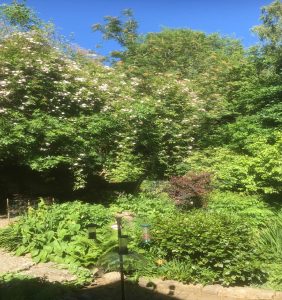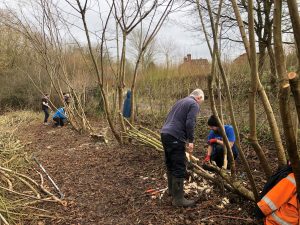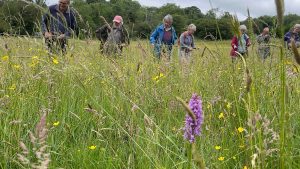12 Actions to Tackle the Climate Emergency and Biodiversity Crisis – by John Box CEcol CEnv FCIEEM
Each month over the next year try one of these ideas for actions
We can all play a part in tackling the inter-related climate emergency and biodiversity crisis. Hope is created by actions. One action leads to another.
“Don’t be discouraged by people saying your actions are just a drop in the ocean. What’s an ocean except millions and millions of drops? If you’ve ever seen a stalactite or a stalagmite, you’ll know small drops can produce spectacular results.” Isabel Losada, The Joyful Environmentalist, page 3. 2020.
- Using less oil, gas and coal is the most vital action we can all take. Burning these fossil fuels generates the blanket of CO2 pollution trapping heat in our atmosphere. Green energy sources – the wind, the sun and the tides – generate no CO2 emissions once operational and are renewable. At work and at home, try to cut down on using gas and switch to a green energy supplier for electricity if that’s feasible. Buses and trains are better than cars and planes. Even better for getting around and transporting things are cycles, tandems, e-bikes and cargo bikes.
- Eating food, vegetables and fruit grown locally helps support agriculture and the countryside. Food grown in Europe or further afield and flown or shipped here has a much larger carbon footprint. We should be looking for seasonal and plant-based foods and reducing meat and dairy products.
- Simple carbon calculators are available online to work out your own carbon footprint. More accurate carbon calculators can be set up for your workplace or home using the UK Government conversion factors for a very wide range of carbon emissions.
- Designing open space and landscape schemes offers us opprtunities to be creative as does any landscaping at our offices and with our own gardens, window boxes and allotments. Specify plants for landscape schemes that were cultivated in the UK using peat-free soils. Herbaceous perennials are better than annuals or bedding plants. Trees and shrubs can provide shade, create cool places, manage surface water and create habitat structure for a wide range of species. Above ground floral diversity means underground complexity and associated carbon capture. “Don’t dismiss soil: its unknowable wonders could ensure the survival of our species” (George Monbiot)

Gardens with shrubs and trees make cool and shady places to sit
- Gardens with lots of bushes and shrubs and trees are much shadier and cooler. Think about how refreshing woodlands are. Allow gardens to grow upwards to create cool and shady places. Shrubs and trees will also give perches and nesting places for birds and lots of insects for them to feed on. Adding a pond helps to create a cooler microclimate and provides water and habitats for frogs, newts and dragonflies. Peat-free compost or home-made compost improves soil structure and organic content, especially on sandy or clay soils. Window boxes full of luxuriant flowers will do their bit for absorbing CO2, brighten up flats and houses and attract butterflies. Penny Anderson’s wonderful blog explains more about getting your garden and window boxes to absorb more carbon and attract more wildlife.

Bug houses are fun to make and provide microhabitats for minibeasts
- Microhabitats for minibeasts. Bug houses are great fun to build from odds and ends and can be filled with all sorts of things – short pieces of bamboo, bits of brick, hair brushed from the dog, dried leaves and pinecones, feathers and more to encourage bugs and creepy crawlies. Small piles of brick ends and stones can be hidden away in the corners of a garden creating ideal places for snails, beetles and all sorts of invertebrates to live and overwinter.
- Volunteer to help CIEEM through its standing committees, national and regional sections, working groups and special interest groups, including the Action 2030 working group who focus on addressing the climate emergency and biodiversity crisis. Getting involved locally with practical activities through a wildlife trust or wildlife group will help to improve the capacity of wildlife habitats to absorb CO2, increase their biodiversity and is great fun.

Restoring functionality to a planted hedge that was not managed

Counting orchids to monitor meadow restoration
- Join other environmental organisations. Or take out a subscription to British Wildlife, which is such a rich source of up to date articles about natural history, or Conservation Land Management which is such a good source of technical information for those doing practical work with habitats.
- Integrate the climate emergency and biodiversity crisis into your professional work. Make your views known on projects that you are involved with that have associated climate and biodiversity impacts. Employers and clients are increasingly aware of the need to tackle the effects of climate breakdown and the losses of biodiversity. Track down the policies – climate change, biodiversity, sustainability, the environment – of the organisations that you work for and belong to. How do the actions actually being taken match up to the policy? How can these organisations improve their environmental performance? You can make a real difference to how organisations tackle climate change, global heating and biodiversity loss. You will find allies to give you confidence and encourage you to take more actions.
- Banks, building societies and pension providers will have broad environmental social and governance policies. Vote with your feet, ask questions and persist in insisting on change.
- Your local councillor, local authority councillor or community councillor are really useful contacts. Can your council do more to reduce its CO2 emissions? Can they do more to help biodiversity?
- Hopefully your MP supports net zero and green issues. Find out if they do. What are they doing locally to help us all tackle these hot summers? Reach out to them and ask for a meeting. CIEEM has this excellent webinar on how to engage with politicians and policy makers. There will be a general election this year and the candidates must be asked about their views on how to tackle climate change, global heating, climate change and biodiversity loss.
We are ecologists and environmental managers who can best explain the implications of the interlinked climate emergency and biodiversity crisis to those around us. Objectivity and an evidence-based approach are fundamental. In a world of alternative facts, fake news and social media, we need to demonstrate professionalism, integrity and reputation. Of these, integrity is absolutely fundamental and must underpin everything that we do.
 John Box is a CIEEM Fellow and was President from 2012-2015. John chairs the Action 2030 working group which provides challenge and advice to CIEEM on the climate emergency and biodiversity crisis.
John Box is a CIEEM Fellow and was President from 2012-2015. John chairs the Action 2030 working group which provides challenge and advice to CIEEM on the climate emergency and biodiversity crisis.
Blog posts on the CIEEM website are the views and opinions of the author(s) credited. They do not necessarily represent the views or position of CIEEM. The CIEEM blog is intended to be a space in which we publish thought-provoking and discussion-stimulating articles. If you’d like to write a blog sharing your own experiences or views, we’d love to hear from you at SophieLowe@cieem.net.
